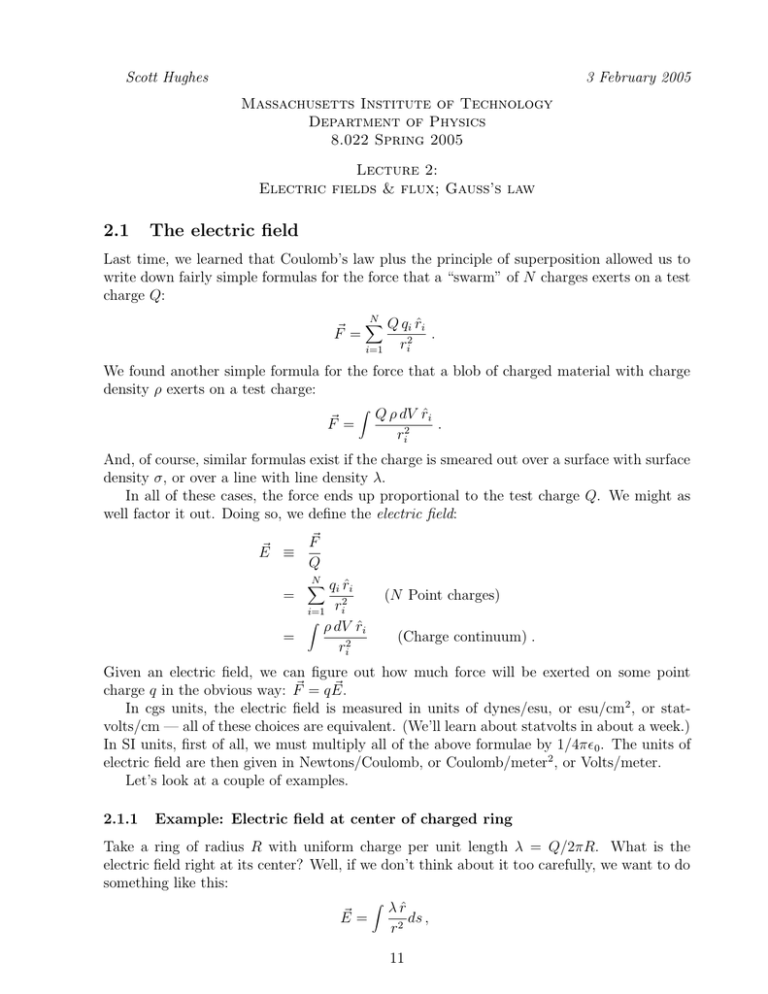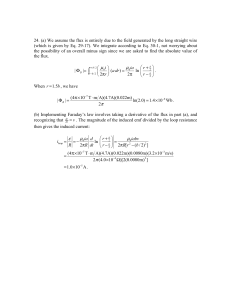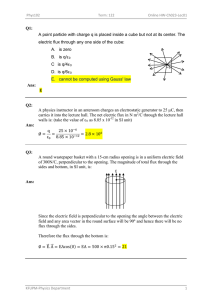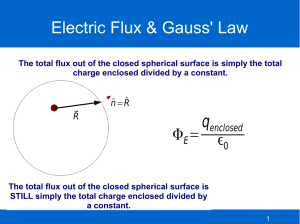2.1 The electric field
advertisement

Scott Hughes 3 February 2005 Massachusetts Institute of Technology Department of Physics 8.022 Spring 2005 Lecture 2: Electric fields & flux; Gauss’s law 2.1 The electric field Last time, we learned that Coulomb’s law plus the principle of superposition allowed us to write down fairly simple formulas for the force that a “swarm” of N charges exerts on a test charge Q: F~ = N X Q qi r̂i i=1 ri2 . We found another simple formula for the force that a blob of charged material with charge density ρ exerts on a test charge: F~ = Z Q ρ dV r̂i . ri2 And, of course, similar formulas exist if the charge is smeared out over a surface with surface density σ, or over a line with line density λ. In all of these cases, the force ends up proportional to the test charge Q. We might as well factor it out. Doing so, we define the electric field: ~ ~ ≡ F E Q = N X qi r̂i (N Point charges) ri2 Z ρ dV r̂i = ri2 i=1 (Charge continuum) . Given an electric field, we can figure out how much force will be exerted on some point ~ charge q in the obvious way: F~ = q E. In cgs units, the electric field is measured in units of dynes/esu, or esu/cm2 , or statvolts/cm — all of these choices are equivalent. (We’ll learn about statvolts in about a week.) In SI units, first of all, we must multiply all of the above formulae by 1/4π²0 . The units of electric field are then given in Newtons/Coulomb, or Coulomb/meter2 , or Volts/meter. Let’s look at a couple of examples. 2.1.1 Example: Electric field at center of charged ring Take a ring of radius R with uniform charge per unit length λ = Q/2πR. What is the electric field right at its center? Well, if we don’t think about it too carefully, we want to do something like this: ~ = E Z λ r̂ ds , r2 11 where the integral will be take around the ring; ds will be a path length element on the ring, r is the radius of the ring, and r̂ is a unit vector pointing from each length element on the ring to the ring’s center ... But wait a minute! You should quickly notice that for each contribution due to a little length element on the ring, there is an equal contribution from the ring’s opposite side ~ field at the center of the ring pointing in the opposite direction. Each contribution to the E is precisely canceled by its opposite contribution: So the field at the center of the ring is zero. 2.1.2 Example: Electric field on ring’s axis Suppose we move along the ring’s axis to some coordinate z above the disk’s center. The field does not cancel in this case, at least not entirely: Considering the contribution of pieces of the ring, we see that there is a component in the radial direction, and a component along z. The radial component cancels by the same symmetry argument as we used above. The z component, however, definitely does not cancel: Vectorial contribution to field cancels in radial direction, does not cancel in z direction. θ Height above ring z Radius R So, let’s calculate: the contribution coming from a little segment of the ring is ~ = dE dQ cos θ ẑ r2 12 λ ds cos θ ẑ + z2 λ z ds = ẑ . (R2 + z 2 )3/2 = R2 The length ds represents the length of a little segment of the ring. Integrating this up is trivial: we go around the circumference, so the only “action” as far as the integral is concerned is that we replace ds with 2πR. We end up with 2πR λ z ẑ (R2 + z 2 )3/2 Qz = ẑ . 2 (R + z 2 )3/2 ~ = E 2.1.3 Example: Electric field on disk’s axis ~ field, that above a Using that result, it is now simple to work out a more complicated E disk. Suppose we have a charge Q smeared out uniformly over a disk of radius R, so that ~ a distance z above the disk? the charge per unit area σ = Q/πR2 . What is E A simple way to do this is to consider the disk to be made out of an infinite number of infinitesimally thin rings: A single ring of radius r and thickness dr carries a total charge dQ = σ 2πr dr. The contribution of that ring to the disk’s electric field can be easily figured using our ring electric field result, replacing R with r and Q with dQ: ~ = σz ẑ dE 2πr dr . + r2 )3/2 (z 2 To get the total field, we integrate this from r = 0 to r = R: 2πr dr + r2 )3/2 0 à ! z z = 2πσẑ √ − √ 2 . R + z2 z2 ~ = E Z R σz ẑ (z 2 13 Before moving on, it’s useful to consider two limits of this formula. First, consider z large and positive: this formula can be rewritten ~ = 2πσẑ 1 − q E 1 1 + (R/z)2 1 R2 ' 2πσẑ 1 − 1 − 2 z2 Q πR2 σẑ = ẑ . = z2 z2 " à !# On the second line we have used z À R to expand the square root via the binomial expansion. ~ field as a point charge — The final result tells us that, at large z the disk has the same E which should not be a surprise! √ Next consider z very small and not necessarily positive: putting z 2 = |z|, we have à ~ = 2πσẑ z − √ z E |z| R2 + z 2 z . ' 2πσẑ |z| ! The function z/|z| = +1 above the disk, and −1 below the disk. Thus, our electric field has constant magnitude, E = 2πσ, and points away from the disk: up on the top side, down on the bottom. Remember this result — we will see it again soon! 2.2 Electric field lines A useful concept to illustrate the electric field is the notion of field lines. These are fictitious lines we sketch which point in the direction of the electric field, and whose density gives us (at least roughly) an idea of how strong the field is. Here is a sketch of the electric field lines around a pair of point charges: − + The field lines are bunched up near the charges (where the field is strongest), and spread out farther away. They point in towards the minus charge, and away from the plus charge. Field lines can never cross. If they did, what would the field direction be at the crossing point? It wouldn’t be defined! Sometimes you have situation where it seems like field lines are crossing; it usually turns out the magnitude goes to zero when that happens. 14 2.3 Flux The notion of flux is an important one in physics. It refers to the flow of some vectorial quantity through an area. The simplest example to picture is the flow of fluid. Imagine that fluid is flowing with velocity ~v = vx̂. Now imagine that we dip a square wire loop of cross ~ = An̂, where n̂ is the section area A into this fluid. We describe this loop with a vector A normal to the plane of the loop: Loop, area A Unit normal n^ The velocity flux Φv is defined as the overlap between the velocity vector ~v and the loop ~ area A: ~. Φv = ~v · A For a uniform, plane loop, and constant, uniform velocity ~v , we have Φv = vA cos θ, where θ is the angle between n̂ and the velocity vector: θ Φ=vA Φ = v A cos θ Φ=0 For this example, the rate of fluid flow through this loop is proportional to this flux, Φ v . What if things aren’t nice and uniform like this? Then, we break the cross sectional area ~ we assign each square its own normal n̂. The flux then of the loop up into little squares dA; becomes an integral: Φv = Z ~. ~v · dA The integral is taken over the entire surface through which we wish to compute the flux. 15 2.4 Electric flux and Gauss’s law (intuitive picture) The electric flux ΦE (which I’ll usually just write Φ) is just like the velocity flux discussed ~ rather than the fluid velocity ~v : above, using the electric field E Φ= Z Surface ~ · dA ~. E Electric flux has a very nice interpretation in terms of field lines. To motivate this interpretation, imagine that we have a uniform electric field. Let’s calculate the flux through a square with cross sectional area A: θ Uniform electric field ~ · (An̂) = EA cos θ . Φ = (E) No surprise — it looks just like the velocity flux we discussed above. The cool thing is how we can interpret this: the electric flux Φ is proportional to the number of field lines that pass through the loop!1 In this case, we can see that when θ = 0 we have the maximum possible number of field lines passing through the loop. The number of lines that can fit decreases as we tilt the loop until, when θ = π/2, no lines go through. This interpretation holds perfectly well if we make our surface more complicated: if we make the surface wiggly, Edge of wiggly surface Uniform electric field 1 A reasonable objection to raise at this point is that field lines are really fictitious — is the notion that the number that passes through the loop at all meaningful? The answer is yes, provided that we remember it is just the proportionality that means anything. We can’t actually calculate the number of field lines passing through the loop without defining some convention for what the density of field lines means. Clearly, though, we can see when the number that flow through is maximum — θ = 0 — and minimum — θ = π/2. Those statements are independent of any convention defining the field lines. 16 the total electric flux found by integrating over this surface still has this interpretation that it is the number of field lines passing through the surface. A particular interesting and important case is when the surface is closed: Closed surface S Uniform electric field What is the flux that we find integrating over the total surface? With our intuitive interpretation, the answer is obvious: Φ=0. Why? Just as many field lines enter the surface as leave it! Mathematically, you can ~ is see where this comes from by noting that the unit normal n̂ for each area element dA continually pointing in different directions as we move over the closed surface. On the left side of S, it mostly points to the left; on the right, mostly to the right. Summing over all elements we end up with a net cancellation. What if we have a closed surface that only has field lines entering or leaving? As an example, imagine that we enclose a point charge q within a spherical surface of radius r: r q The electric flux through this surface is Φ= I ~ · dA ~ = qr̂ · 4πr2 r̂ = 4πq . E r2 H (The symbol is used for integrals over closed surfaces, or around a closed path, etc.) The ~ field is constant integral was simple to do: since the surface of the sphere is at radius r, the E there; and, the normal vector is just the radial unit vector r̂. 17 What if we the surface is not spherical? It turns out we get exactly the same answer! I’ll derive this carefully in the next section. An intuitive explanation is to use the Gaussian amoeba. We take an arbitrarily shaped closed surface S containing a charge. We then carve a sphere out of it, breaking the region up into the “nucleus” and “protoplasm” of our amoeba: = + q q q Flux through S1 Flux through S2 Flux through S Notice, in this picture, the orientation of the normals to the various surfaces. The original surface S has its normals pointing outward, as usual. Normals to the bounding surface of the “nucleus” S1 also point outward. The bounding surface S2 is a bit wierd: the surface that abuts the “nucleus” has inward normals; the surface on the outer edge has normal pointing outward as normal. The inward normal on the inner surface ensures that when we combine surfaces S1 and S2 , the inner bits cancel and only the original surface S is left over. Whereas the flux through S is hard to compute, the fluxes through S1 and S2 are easy: Φ1 = Φ2 = I I S1 ~ · dA ~ = 4πq E S2 ~ · dA ~=0. E The first result holds because the surface S1 is a sphere, and we can use the flux through a sphere result we already worked out. The second result holds because the number of field lines entering the surface S2 on the inner edge is exactly equal to the number that leave S2 on the outer edge. The total flux through the surface S is therefore 4πq: Φ= I S ~ · dA ~ = 4πq . E Just like for a sphere. What if there’s more than one charge inside S? We just invoke superposition, and compute the flux from each individual charge; then we add the result. It’s pretty obvious what we get: Φ= I S ~ · dA ~ = 4π E N X qi . i=1 We have just worked out Gauss’s Law: The electric flux Φ through a closed surface S is equal to the total charge contained inside S. Mathematically, we say Φ= I S ~ · dA ~ = 4πq(Contained within S) . E 18 This is in CGS units; in SI units, the factor 4π becomes 1/²0 . 2.5 Gauss’s law: More careful proof Let’s revisit the Gaussian amoeba and show the flux is 4πq independent of the surface’s shape a little more carefully. Consider a cone of solid angle dΩ that goes out from the charge through both the spherical “nucleus” and out to the “real” surface: ^n θ R r The cone intersects the sphere at radius r; the surface of intersection is a circle whose area is da = r 2 dΩ, oriented parallel to r̂. The electric flux through this patch is qr̂ 2 · r dΩ r̂ = q dΩ . r2 The cone intersects the outer surface at a radius R. The surface of intersection is a very small ellipse whose area is R2 dΩ/ cos θ, oriented parallel to n̂, which is inclined at an angle θ with respect to r̂. The electric flux through this patch is dΦsphere = qr̂ R2 dΩ n̂ · R2 cos θ n̂ · r̂ = q dΩ cos θ = q dΩ . dΦS = The fluxes through each differential patch are equal; integrating over the total solid angle (4π steradians) subtended by each surface, we find the same flux: ΦS = Φsphere = 4πq. The generalization to multiple charges is then simple; Gauss’s law follows. 2.6 Using Gauss’s law As I hope you’ll come to appreciate, Gauss’s law is our friend: in situations with lots of ~ really easy. The caveat is that it is only useful for this symmetry it makes calculating E 19 purpose when there’s enough symmetry. Gauss’s law is always true, but it is not always useful in this way. The simplest example is the case of spherical symmetry. 2.6.1 Example: Spherical symmetry Suppose we’ve got some perfectly spherical distribution of charge, with density ρ(r). (Note that this density is a function of radius.) Enclose this distribution with a spherical surface S of radius r. Gauss’s law tells us I S ~ · dA ~ = 4πq(inside S) . E ~ must point in the radial direction: E ~ ∝ r̂. Further, Since the field is spherically symmetric, E it can only depend on r, which means that it is constant over any spherical surface. The integral is thus easy to evaluate: I S ~ · dA ~ = 4πr 2 E(r) . E The amount of charge contained inside S is given by integrating the charge density ρ(r) over the volume V contained by S: Z q= V ρ(r) dV . So, ~ E(r) = R V q(r) ρ(r) dV r̂ = 2 r̂ . 2 r r Let’s specialize this further: put ρ(r) = ρ = 0 r≤a r>a. (ρ is a constant.) Then, q(r) = = Z ZVr 0 ρ(r) dV 4πρ r2 dr 4 3 = πr ρ 3 4 3 πa ρ = 3 r≤a r>a. The electric field is 4 ~ E(r) = πρ rr̂ r≤a 3 4πρa3 /3 = r̂ r>a. r2 The electric field grows linearly with r inside the sphere, but falls off as 1/r 2 outside the sphere. In fact, the external field is exactly that of a point charge q = 4πρa3 /3. 20 2.6.2 Example: Spherical symmetry 2 Suppose we’ve got a spherical shell of radius a, and a total charge q is distributed over the shell, so that the charge per unit area on the shell is σ = q/4πa2 . What is the electric field in this case? a Consider two Gaussian surfaces, one at r < a, one at r > a. For r < a, we have 4πr2 E(r) = 4πq(r < a) = 0 → E(r) = 0 r<a. There is no electric field anywhere inside the shell! On the outside, we have 4πr2 E(r) = 4πq(r > a) = 4πq q → E(r) = 2 r>a. r Outside, it looks just like a point charge sitting at the origin! The exterior of spherical charge distributions always look just like point charges at the origin. Notice that, as we go from just barely inside the shell to just barely outside the shell, the electric field jumps suddenly: ∆E = 4πa2 σ q − 0 = = 4πσ . a2 a2 This discontinuous jump ∆E = 4πσ as we “cross” a sheet of charge per unit area σ is a general feature of such charge distributions. We see it in another example: 21 2.6.3 Example: Infinite sheet Suppose we have a sheet of charge, lying in the (x, y) plane, and stretching out all the way to infinity. What is the electric field a distance z away from this sheet? One way to do this would be to use the calculation of the disk we did earlier on, and take the limit R → ∞. Here, we’ll use Gauss’s law: we make a “Gaussian pillbox” around the sheet like so: E(z) z z Disk has cross section area A E(z) Now, we think about the symmetry of the problem to figure out what Gauss’s law tells us. The electric field cannot depend on our horizontal position — the sheet is the same in all directions, so all horizontal positions are identical. The field must also point either out (if it is positive charged) or in (negative). Finally, there can be no flux through the sides of the pillbox — the field can only point straight out by the planar symmetry. (If it did not, imagine rotating the plane — the field would change direction. That contradicts the notion that it is the same everywhere.) Gauss’s law reduces to Φ = 2AE(z) . The total charge contained inside the pillbox is σA, so we find E(z) = 2πσ . Notice three things here: first, this is the same field we found for the disk when z was very small. When we get extremely close to something like a disk, the infinite sheet calculation is approximately the electric field — essentially, you get so close that you can’t “see” the edges of the disk, and it acts as though it were infinite. Second, this electric field is independent ~ is uniform all through space. Third, we see once again that, when we cross of distance — E a sheet of uniform charge density, the change in the electric field is 4πσ. In this case, it is 2πσ pointing down below, and 2πσ pointing up above. 22






